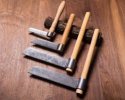- Joined
- Mar 4, 2018
- Messages
- 167
Hi guys,
I'm following a custom maker who's using various lengths and thicknesses.
In fact, i was looking at a high saber gind (the top flat part of the blade is like a bit less than one third of the height wich is 36mm), and i wondered, do you loose that much slicing ability by gaining thickness ?
On something like an "outdoor" multipurpose blade of 130mm, with the grind i described, will you loose that much cutting ability by increasing your thickness by one millimeter compared to the solidity increase it represents ?
if you take a 4mm or a 5mm blade, will the slicing ease be that much different with the same grind ?
Is the extra mm worth ?
thanks for enlightening me guys !
I'm following a custom maker who's using various lengths and thicknesses.
In fact, i was looking at a high saber gind (the top flat part of the blade is like a bit less than one third of the height wich is 36mm), and i wondered, do you loose that much slicing ability by gaining thickness ?
On something like an "outdoor" multipurpose blade of 130mm, with the grind i described, will you loose that much cutting ability by increasing your thickness by one millimeter compared to the solidity increase it represents ?
if you take a 4mm or a 5mm blade, will the slicing ease be that much different with the same grind ?
Is the extra mm worth ?
thanks for enlightening me guys !

